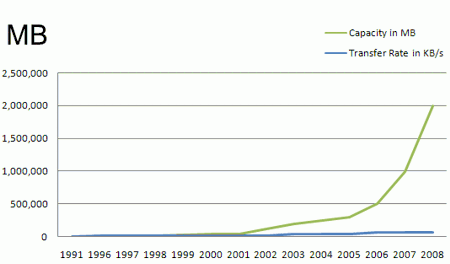visits
1291
votes
5
votes++Vote positively this post :)
+20
votes--Vote negatively this post :(
-15
Magnetic Hard Drives: its end is near

Recently Hitachi, in colaboration with several enterprises and universities of Japan, have developed a new nano-technology that will allow to the future hard disk of 3.5 inches, arrives to about 12 TB and the 2.5 to about 4 TB of capacity, approximately. These news hard disk will have 3.9 TB by inch² instead of the acual 488 GB.
The increase of capacity of the hard disks doesn't accomplish the Moore's Law, because its growing is exponential, is that to say that its capacity doesn't double every year, but if in one year doubles it, in the next quadruples it and in the next octuples it, as shows the following graph.

This exponential growing of capacity of storage is the base for some business models as the one of Google, disposing of the capacity of store every time more cheaper.
This situation will cause that within some years will arrive to the limit of this technology, the point where the capacity of the hard disk can't be increased, due to that the magnetic domains where the bits of information are stored can't be reduced more, so we will have to replace it by another technology. Other good reason to replace the magnetic hard drives in the future, is the fact of that the increase of speed have been minimum in relation to the increase of capacity, so although we have a hard drive with a lot of TB, if we have to spend thirty minutes in copy only a few thousand of Gigabytes, we will end trying to avoid work with big files.

But, Will we arrive to need really that store capacity? I'm sure that yes, probably will end storing all the videos and the music with the maximun quality with a compression format without loss of information, the games will come with more video sequences, the programs will be more big, etc.
Another time I will talk more deeply about the functioning of the magnetic hard drives and the candidate technologies to replace it. I'm talking about the solid state disk and holographic memories.